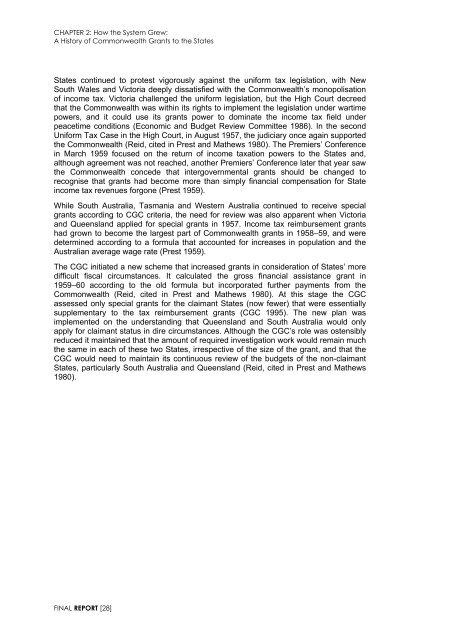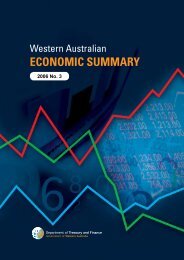Garnaut Fitzgerald Review of Commonwealth-State Funding
Garnaut Fitzgerald Review of Commonwealth-State Funding
Garnaut Fitzgerald Review of Commonwealth-State Funding
You also want an ePaper? Increase the reach of your titles
YUMPU automatically turns print PDFs into web optimized ePapers that Google loves.
CHAPTER 2: How the System Grew:<br />
A History <strong>of</strong> <strong>Commonwealth</strong> Grants to the <strong>State</strong>s<br />
<strong>State</strong>s continued to protest vigorously against the uniform tax legislation, with New<br />
South Wales and Victoria deeply dissatisfied with the <strong>Commonwealth</strong>’s monopolisation<br />
<strong>of</strong> income tax. Victoria challenged the uniform legislation, but the High Court decreed<br />
that the <strong>Commonwealth</strong> was within its rights to implement the legislation under wartime<br />
powers, and it could use its grants power to dominate the income tax field under<br />
peacetime conditions (Economic and Budget <strong>Review</strong> Committee 1986). In the second<br />
Uniform Tax Case in the High Court, in August 1957, the judiciary once again supported<br />
the <strong>Commonwealth</strong> (Reid, cited in Prest and Mathews 1980). The Premiers’ Conference<br />
in March 1959 focused on the return <strong>of</strong> income taxation powers to the <strong>State</strong>s and,<br />
although agreement was not reached, another Premiers’ Conference later that year saw<br />
the <strong>Commonwealth</strong> concede that intergovernmental grants should be changed to<br />
recognise that grants had become more than simply financial compensation for <strong>State</strong><br />
income tax revenues forgone (Prest 1959).<br />
While South Australia, Tasmania and Western Australia continued to receive special<br />
grants according to CGC criteria, the need for review was also apparent when Victoria<br />
and Queensland applied for special grants in 1957. Income tax reimbursement grants<br />
had grown to become the largest part <strong>of</strong> <strong>Commonwealth</strong> grants in 1958–59, and were<br />
determined according to a formula that accounted for increases in population and the<br />
Australian average wage rate (Prest 1959).<br />
The CGC initiated a new scheme that increased grants in consideration <strong>of</strong> <strong>State</strong>s’ more<br />
difficult fiscal circumstances. It calculated the gross financial assistance grant in<br />
1959–60 according to the old formula but incorporated further payments from the<br />
<strong>Commonwealth</strong> (Reid, cited in Prest and Mathews 1980). At this stage the CGC<br />
assessed only special grants for the claimant <strong>State</strong>s (now fewer) that were essentially<br />
supplementary to the tax reimbursement grants (CGC 1995). The new plan was<br />
implemented on the understanding that Queensland and South Australia would only<br />
apply for claimant status in dire circumstances. Although the CGC’s role was ostensibly<br />
reduced it maintained that the amount <strong>of</strong> required investigation work would remain much<br />
the same in each <strong>of</strong> these two <strong>State</strong>s, irrespective <strong>of</strong> the size <strong>of</strong> the grant, and that the<br />
CGC would need to maintain its continuous review <strong>of</strong> the budgets <strong>of</strong> the non-claimant<br />
<strong>State</strong>s, particularly South Australia and Queensland (Reid, cited in Prest and Mathews<br />
1980).<br />
FINAL REPORT [28]

















